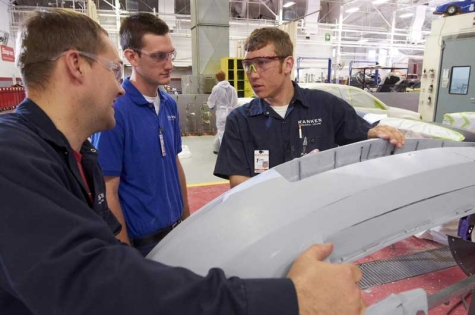I know that easily one of the top challenges at many collision repair businesses around the country is finding skilled technicians, either entry-level or those with more experience.
That’s why I was so encouraged and impressed by what I’ve seen at Ranken Technical College in St. Louis, MO.
At this stage in my career, it can be hard to impress me, but I’ve been blown away by what I’ve seen at Ranken the half-dozen times I’ve visited there. So much so, I’ve chosen to bring all the auto body shops in a number of my 20 Groups to the school to check it out.
Here’s what I think sets Ranken apart from many other collision repair training programs:
First, the facility is phenomenal. It’s probably equally or even better equipped than most shops in the U.S.
Second, when I’ve visited other collision repair training programs, I often see students working on older cars or even restoration projects. Sure, students can learn some skills they will need by working on that type of vehicle. But at Ranken, students are working on exactly the late-model vehicles they will find in the auto body shops that will employ them.
But here’s what I love most about the Ranken program. Every student in the Collision Engineering program is on an eight-week rotation. They attend classes and hands-on training at the school for an eight-week period, learning the basics like shop safety, vehicle disassembly and dent repair---an awesome part of the program is that researching OEM repair procedures is one of the first skills students learn.
Then they spend the next eight weeks actually working in a shop, performing the skills they have learned---along with being exposed to more of the type of work they will be doing as technicians. If they’re not performing a skill within the shop to the level they should be, the shop can contact the school’s instructors and have them work with that student further.
This eight-week rotation between the school and the shop continues throughout the student’s time in the two-year Ranken program. Rather than going to school for a full year, being introduced to skills they may well forget before they have a chance to practice them, Ranken students are getting a real-world chance to use, improve and demonstrate those skills.
The facility for Ranken Technical College’s Collision Engineering program rivals that of the best shops in the industry.
At some point in the rotation, they need to choose whether they want to become a body technician or a painter, and from that point on, that’s what their training at the school and work in the shop will focus on.
As with any collision repair training program out there, a student who completes the Ranken program is not going to immediately be a journeyman A-tech. But Ranken graduates will be really strong B-techs.
At many programs, students learn just a little about a lot. At Ranken, they come away with the specific training and hands-on experience to be productive at the basic skills needed in a shop right away to continue to progress in their career. They also start that career with a basic set of tools, and a bunch of I-CAR training credits.
As I said, I’m not easy to impress. But the quality of the welds I saw students at Ranken doing was phenomenal. One of the times I visited, an instructor was working with students on a quarter panel replacement. Everything was being done exactly how the OEM procedures---which the students had access to---call for it to be done.
For more information about the Ranken program, contact Shelly Jones at sajones@ranken.edu.
Now you might be thinking: That’s great, Mike, but my shop is nowhere near St. Louis. So here are a few more things you should know.
I have been so impressed with the Ranken facility, I moved the hands-on ADAS training we do for Nissan/Infiniti from Florida to Ranken. So come take that training and see Ranken for yourself.
The school has a dorm and cafeteria for students who don’t live in the area. I know a shop owner in Colorado who, like me, was so impressed with Ranken, he’s having his own son attend the program there.
If I still had my shops and I found good prospective apprentices, I would definitely have them attend the Ranken program. I’d tell them they would need to line up the grants, scholarships or loans needed initially to pay for the program themselves. But I’d also have an agreement with them that as long as they were working for my company and doing a good job, I would make their student loan payments. They’d have some skin in the game up front, but also a strong incentive to stay at my company.
And here’s the really good news for the industry: I want to give a big shout-out to the Enterprise Rent-A-Car Foundation, because they have gotten behind the Ranken program. What’s more, the foundation is helping fund a pilot project to bring the Ranken model, including that awesome eight-week rotation system, to other schools around the country, including Contra Costa College in San Pablo, CA; Texas State Technical College in Waco, TX; and College of Lake County in Grayslake, IL.
As the pilot project continues, participating schools, shops and students are perfecting an awesome model for what entry-level collision repair training should look like. Get involved if you can. I truly believe it will be a key part of improving the development of the entry-level technicians this industry so badly needs.














Mike Anderson